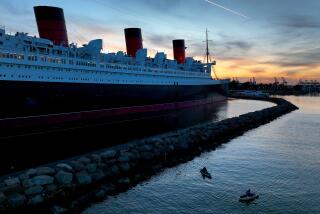Will the Classic Liners Survive?
- Share via
Next year marks a major turning point for ship owners around the world, who must decide whether to pour a substantial amount of money into bringing vintage vessels up to Safety of Life at Sea code requirements or let them retire from North American cruise service.
Here’s a quick rundown on the most famous classic liners and their probable futures:
*
Cunard’s Queen Elizabeth 2: The unique but sometimes-maligned flagship and ocean liner has received a vote of confidence from owners Cunard Line and, presumably, Scandinavia’s Kvaerner Co., recent purchasers of Cunard’s parent company, Trafalgar House, which was bought for $1.3 billion. The QE2 is slated for an $18-million upgrading on its regular biennial dry-dock renovations this fall, which will bring it into compliance with SOLAS.
Among the planned improvements are the elimination of 260 passenger berths in the smaller inside cabins on the lower decks; the upgrading of the restaurant to single-seating service, and the addition of an extra day on transatlantic crossings--from five days to six--to allow a more leisurely voyage and more convenient departure times for passengers. In 1997, the updated QE2 will carry 1,500 passengers on 17 transatlantic sailings, plus more sailings and longer cruises in various parts of the world. The ship first entered service in 1969 and was christened by Queen Elizabeth.
*
Norwegian Cruise Line’s Norway: The Norway--formerly the celebrated France from French Lines, christened in 1960--will cross the Atlantic to Le Havre, France, and Southampton, England, in September for the first time in 17 years. A scheduled dry-docking in Southampton will bring the vessel up to SOLAS standards. The ship sails from Miami on Aug. 31, from Charleston, S.C., on Sept. 1 and New York on Sept. 3, arriving in Le Havre on Sept. 10 and Southampton on Sept. 11. Fares range from $1,149 to $4,499 per person, double occupancy, without air fare.
The crossing will celebrate the history of the France.
*
Holland America’s Rotterdam: The fifth Holland America liner to bear the name Rotterdam, which entered service in 1959, will be retired Sept. 25, 1997, on the same day the new Rotterdam VI, now under construction in Italy’s Fincantieri shipyard, debuts. HAL decided bring out a new version of its classic flagship rather than undertake the arduous and costly task of bringing the 38-year-old steamship up to code.
The bigger (62,000 tons), faster (up to 25 knots) new vessel will be the first of a new series of ships for the 123-year-old line.
*
American Hawaii’s Constitution: The venerable American-built Constitution, launched in 1951, has been laid up because, according to an American Hawaii spokesman, it would be too costly to restore and bring up to SOLAS standards. One estimate of the work was about $60 million. While owners American Classic Voyages, which also operates the Delta Queen Steamboat Co.’s three vessels, expressed an interest in acquiring another ship to replace the Constitution, they admit finding the requisite U.S.-built ship would be difficult. Sister ship Independence, extensively refurbished in 1994, will continue to sail weekly around the Hawaiian islands.
*
Cunard’s Sagafjord: The Sagafjord, which had been scheduled to retire from the Cunard fleet at the end of the 1996 Alaska season, took an involuntary early retirement after an engine room fire and loss of power in February off Subic Bay in the Philippines. After undergoing repairs in Singapore, it was chartered by German tour operators Transocean to sail in northern Europe from mid-July through the remainder of the 1996 season. The ship will be renamed Gripsholm after a popular Swedish America Line vessel from the 1950s that last sailed as the Regent Sea for now-defunct Regency Cruises.
When a ship is retired by its owner, it does not necessarily go to the breakers to be taken apart and sold as scrap metal. Most often, it is put up for sale or lease to a company that will operate it in Europe or Asia, where SOLAS regulations do not apply.
More to Read
Sign up for The Wild
We’ll help you find the best places to hike, bike and run, as well as the perfect silent spots for meditation and yoga.
You may occasionally receive promotional content from the Los Angeles Times.






